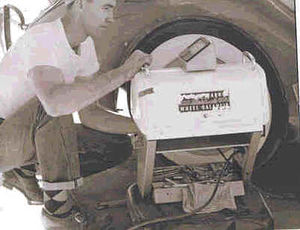Milestones:Merrill Wheel-Balancing System, 1945
Merrill Wheel-Balancing System, 1945
Denver, CO, USA September 1999 - IEEE Denver Section
(IEEE Milestone and ASME Landmark)
In 1945, Marcellus Merrill first implemented an electronic dynamic wheel-balancing system. Previously, all mechanical methods were static in nature and required removing the wheels from the vehicle. Merrill's innovative balancing system came to be widely used internationally. Elements of the dynamic balancing systems are still used today, primarily for industrial and automotive production applications.
The plaques can be viewed in two locations: Merrill Axle and Wheel Services, 7800 W. 16th St., Lakewood, Colorado; and Merrill Engineering Laboratory, 2390 S. Tejon St., Englewood, Colorado, U.S.A.
In 1945, Marcellus "Celly" Merrill had developed and was manufacturing an innovative wheel balancer for automobiles. At that time, most automotive wheel balancing was done by removing the wheel and tire from the vehicle and then doing some type of static balancing without rotating the wheel. Mr. Merrill came up with the idea of balancing the tire and wheel while they were still mounted on the car. To do this, with the wheel jacked off the ground he would spin the tire and wheel at high speed, and then analyze the resultant vibrations as the wheel coasted to lower speeds. The vibrations were monitored by an electronic pickup which sat on the floor and was attached to the bumper of the car by a magnet on the end of a probe. The signal was used to trigger a stroboscopic light which made the wheel appear to stand still. This light identified the point at which the balance weight should be added. The signal also helped to establish the amount of weight to be added to effect a proper balance. If the wheel to be balanced were a front wheel, it was spun by a "spinner" which consisted of an electric motor with a large flat pulley which was pressed against the wheel. If a rear wheel were to be balanced, only one rear wheel was jacked up and it was spun with the automobile's engine.
The Merrill Wheel Balancing System at this time worked very well except that the electric motors on the wheel spinners were subject to frequent failures. Mr. Merrill contacted the General Electric Co., the manufacturer of these motors, regarding this problem. In turn, the General Electric Co. assigned the problem to Jackson F. Fuller, a young field engineer in its Denver office. The motors were failing because the energy required to accelerate the wheels to a high speed exceeded the design capability of the motors. This caused these ac-series connected motors to overheat with consequent insulation failure. One solution would have been to use larger motors. However, Mr. Merrill resisted this solution as the larger motors would have required more current from their electric supply circuits. This might have exceeded the electric circuit capability in some applications. The problem was solved by changing the insulation materials and installing a larger cooling fan.
Interview with Prof. Jackson F. Fuller
regarding Marcellus "Celly" Merrill
Recorded by John E. Martin
18 April 1998
Map
